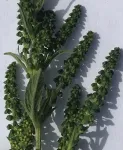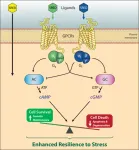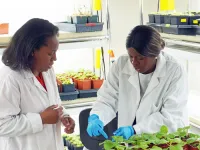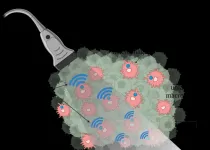(Press-News.org) Animal studies indicate that a new COVID-19 vaccine developed at Rutgers may provide more durable protection against SARS-CoV-2 and its emerging variants than existing vaccines.
“We need a better vaccine, one that provides years of robust protection with fewer booster shots against a variety of SARS-CoV-2 strains. Our data suggest this vaccine candidate might be able to do that,” said Stephen Anderson, associate professor of Molecular Biology and Biochemistry in SAS, resident member of the Rutgers Center for Advanced Biotechnology and Medicine and senior author of the paper in Vaccines.
Existing COVID vaccines often provide some protection against serious disease and death. However, these vaccines typically elicit temporary bursts of protective antibodies that rapidly wane, even after booster doses, leaving most individuals vulnerable to potentially dangerous repeat infections.
This new vaccine, dubbed MT-001, might provide longer-lasting protection against many COVID-19 varieties. “Thankfully, the current vaccines saved many lives, but they’re still not optimal in some important respects,” said Anderson. “They may not durably prevent people from getting sick.”
Rutgers researchers developed MT-001 using technological approaches informed by an ambitious National Institutes of Health project that aimed to create an antibody for every protein in the human body.
Both FDA-approved RNA vaccines (and most other vaccines approved worldwide) use the entire COVID-19 spike protein as the trigger for the immune response. The new MT-001 vaccine candidate uses a unique section of that spike protein as its immunogen. This brings several advantages.
First, the spike protein section in this immunogen encompasses most of the targets for protective antibodies, including regions that are likely to remain unchanged in (and thus remain effective against) future variants. The data suggest that MT-001 (or its updated booster version) may elicit “broadly neutralizing” antibodies that confer protection against SARS-CoV-2 strain variants currently circulating in the human population and future variants that have not yet appeared.
Second, MT-001 was designed to be relatively straightforward to manufacture and distribute without special low-temperature handling. This could make vaccines based on the MT-001 prototype readily accessible from stockpiles, even in places where cold-storage infrastructure is lacking, should a coronavirus pandemic flare up again.
“In theory, it’s possible that a booster shot of our variant-updated version of MT-001 could provide lifelong protection. The animal data indicate that it should, at the very least, provide protective antibody levels for at least a year or more, which is a vast improvement over today’s vaccines, particularly given that many people are clearly unwilling to get a booster every few months,” said Anderson. “Our goal is to enable people to put the fear of catching COVID behind them.”
Vaccine development and testing were funded in part by the Rutgers Center for COVID-19 Response and Pandemic Preparedness and the New Jersey Health Foundation. Key collaborators included Lisa Denzin and Derek Sant’Angelo of the Rutgers Child Health Institute of New Jersey at Robert Wood Johnson Medical School, Selvakumar Subbian of the Rutgers Public Health Research Institute at New Jersey Medical School and Elliot Campbell, a visiting scientist from Macrotope, Inc., a Rutgers spin-out company.
END
Novel Rutgers COVID vaccine may provide long-lasting protection
2023-05-08
ELSE PRESS RELEASES FROM THIS DATE:
Pollen production could impact climate change by helping clouds form
2023-05-08
For millions of people with seasonal allergies, springtime means runny noses, excessive sneezes and itchy eyes. And, as with many things, climate change appears to be making allergy season even worse. Researchers reporting in ACS Earth and Space Chemistry have shown that common allergen-producing plants ryegrass and ragweed emit more smaller, “subpollen particles” (SPPs) than once thought, yet climate would likely be most affected by their intact pollen grains, which can boost cloud formation.
In addition to annoying sinuses, pollen naturally functions as a ...
Plastic can drift far away from its starting point as it sinks into the sea
2023-05-08
Discarded or drifting in the ocean, plastic debris can accumulate on the water’s surface, forming floating islands of garbage. Although it’s harder to spot, researchers suspect a significant amount also sinks. In a new study in ACS’ Environmental Science & Technology, one team used computer modeling to study how far bits of lightweight plastic travel when falling into the Mediterranean Sea. Their results suggest these particles can drift farther underwater than previously thought.
From ...
Scintillating science: FSU researchers improve materials for radiation detection and imaging technology
2023-05-08
A team of Florida State University researchers has further developed a new generation of organic-inorganic hybrid materials that can improve image quality in X-ray machines, CT scans and other radiation detection and imaging technologies.
Professor Biwu Ma from the Department of Chemistry and Biochemistry and his colleagues have developed a new class of materials that can act as highly efficient scintillators, which emit light after being exposed to other forms of high energy radiations, such as X-rays.
The team’s most recent study, published in Advanced Materials, is an improvement upon their previous research to develop better scintillators. The new design concept produces ...
Webb looks for Fomalhaut’s asteroid belt and finds much more
2023-05-08
Astronomers used NASA’s James Webb Space Telescope to image the warm dust around a nearby young star, Fomalhaut, in order to study the first asteroid belt ever seen outside of our solar system in infrared light. But to their surprise, the dusty structures are much more complex than the asteroid and Kuiper dust belts of our solar system. Overall, there are three nested belts extending out to 14 billion miles (23 billion kilometers) from the star; that’s 150 times the distance of Earth from the Sun. The scale of the outermost belt is roughly twice the scale of our ...
UCI researchers discover new drugs with potential for treating world’s leading causes of blindness in age-related and inherited retinal diseases
2023-05-08
Irvine, CA – May xx, 2023 – In a University of California, Irvine-led study, researchers have discovered small-molecule drugs with potential clinical utility in the treatment of age-related macular degeneration (AMD), diabetic retinopathy (DR), and retinitis pigmentosa (RP).
The study, titled, “Stress resilience-enhancing drugs preserve tissue structure and function in degenerating retina via phosphodiesterase inhibition,” was published in the Proceedings of the National Academy of Sciences.
“In this study, we introduce a new class of therapeutics called ‘Stress ...
First deaf, Black woman receives her PhD in a STEM discipline
2023-05-08
ST. LOUIS, MO - May 8, 2023 – Graduate student Amie Fornah Sankoh recently stood in front of 150 colleagues family and friends at the Donald Danforth Plant Science Center to defend her thesis, Investigating the Effects of Salicylic acid on Intercellular Trafficking via Plasmodesmata in Nicotiana benthamiana. Upon her successful defense, Dr. Amie Sankoh became the first Deaf, Black woman to receive a PhD in any STEM discipline.
Completing a PhD is a challenging undertaking for anyone; to do so without easy access to the kinds of verbal communication that hearing people ...
Microbubble macrophages track tumors #ASA184
2023-05-08
CHICAGO, May 8, 2023 – Macrophages, a type of white blood cell, defend the body by engulfing and digesting foreign particles, such as bacteria, viruses, and dead cells. The immune cells also tend to accumulate in solid tumors, so tracking them could enable new ways to detect cancer and the earliest stages of metastasis.
As part of the 184th Meeting of the Acoustical Society of America, Ashley Alva of the Georgia Institute of Technology will describe how attaching microbubbles to macrophages can create high-resolution and sensitive tracking images useful for disease diagnosis. Her presentation, “Tracking macrophages ...
A cocktail party of 3D-printed robot heads #ASA184
2023-05-08
CHICAGO, May 8, 2023 – Imagine a cocktail party full of 3D-printed, humanoid robots listening and talking to each other. That seemingly sci-fi scene is the goal of the Augmented Listening Laboratory at the University of Illinois Urbana-Champaign. Realistic talking (and listening) heads are crucial for investigating how humans receive sound and developing audio technology.
The team will describe the talking human head simulators in their presentation, “3D-printed acoustic head simulators that talk and move,” on Monday, May 8, at 12:15 p.m. Eastern U.S. in the Northwestern/Ohio State room of the Chicago Marriott Downtown Magnificent Mile Hotel. The talk comes as part of ...
Targeting Mitochondria 2023 will highlight current and future mitochondrial research in October in Berlin
2023-05-08
The World Mitochondria Society is organizing its 14th world conference, Targeting Mitochondria 2023, on October 11-13 at the Steigenberger Hotel Am Kanzleramt, Berlin. Targeting Mitochondria 2023 will address the latest advances and perspectives in mitochondrial research and provide an outlook on future mitochondrial therapies.
Volkmar Weissig, president of the World Mitochondria Society, and Marvin Edeas, president of the scientific committee, said, "This year we will have specific sessions on innovations such as mitochondria in space, exosome-based mitochondrial ...
Uniformity of prey can yield spider-eat-spider world
2023-05-08
A limited menu of prey may weave a tangled food web by emboldening wolf spiders of multiple species to dine on each other and even cannibalize their own, says a study from the University of Nebraska–Lincoln.
Ecologists have long known that predators with otherwise-similar diets can coexist by effectively divvying up the food sources of a community to ease competition and, ideally, leave enough prey for everyone. But analyses of wolf spider species in Nebraska suggest that when the diversity of their mutual prey is lacking, the eight-legged ...








